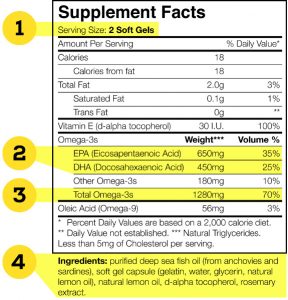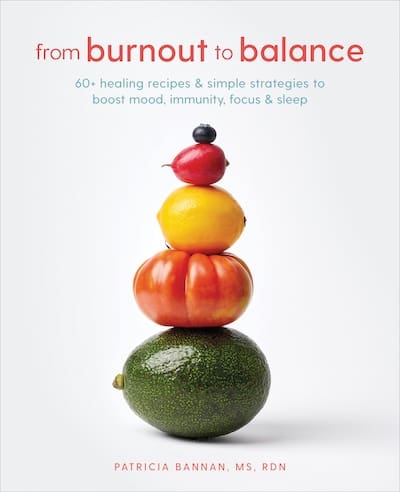I’m delighted to have partnered with the Global Organization for EPA and DHA Omega-3s (GOED) on this blog post. All opinions are my own.
You’ve probably heard that omega-3 fatty acids, found in fatty fish, are healthful and necessary types of fat providing an array of health benefits. But what if you don’t eat fish? Are there plant-based omega 3 options available?
While the short answer is yes, the more complex (and accurate) answer is it’s unlikely you will reap the omega-3 benefits you’ve heard about simply by eating plant-based foods like vegetables, nuts, and seeds.
Read on for the top questions I get asked about plant-based omega-3s, and what you should know if you are looking to benefit from these healthy fats.
What plant-based foods provide omega-3s?
While fish and fish oils are among the most popular forms of omega-3s in the diet, some plant-based foods also contain omega-3 fatty acids, such as flaxseeds, chia seeds, walnuts, hemp seeds, Brussels sprouts, soy foods, pumpkin seeds, and kidney beans. However, the main difference is in the type of omega-3s they contain.
Plant-based sources of omega-3s contain alpha-linolenic acid (ALA), the precursor to the other forms of omega-3s, eicosapentaenoic acid (EPA) and docosahexaenoic acid (DHA), which are found in marine-based sources such as fish and fish oils. According to the vast body of science associated with omega-3s, EPA and DHA are the most important types of omega-3s for overall wellness, including heart, brain, and eye health.
For more information on the importance of omega-3s and brain health, check out “Omega-3s and Brain Health – From Infancy Onward.”
While plant-based foods with ALA provide essential nutrients for the body, only a small amount can be converted into EPA and DHA. In order to get EPA and DHA, you need to eat foods or take supplements with those nutrients.
Do vegetarians need omega-3 supplements?
While consuming a diet with ALA-rich foods is beneficial, most vegetarians still need an omega-3 supplement to boost EPA and DHA levels in the body and to reap the benefits.
Plant-based diets can run the risk of low EPA and DHA omega-3 levels, even if adequate amounts of plant-based omega-3 foods are consumed. According to a study in the American Journal of Clinical Nutrition, only 5-10% of ALA is converted to EPA, and only 2-5% is converted to DHA in the body. While the conversation rate varies greatly from person to person, this study shows overall how difficult it is for someone to meet their EPA and DHA needs solely from plant-based foods.
Including an omega-3 supplement in a plant-based diet that contains both EPA and DHA can help provide the heart, brain, and eye health benefits associated with them.
What can vegetarians take instead of fish oil?
If you’d like an omega-3 supplement with EPA and DHA but do not want to include fish derivatives in your diet, you can choose an alternative with algae, most often found in the form of algal oil. In fact, eating microalgae are how fish get their EPA and DHA as well. The fish eat and store the microalgae in their bodies, therefore making fatty fish a good source of omega-3s for humans.
Certain types of microalgae contain both EPA and DHA, and can provide a plant-based source of these vital nutrients. While more research needs to be conducted for algae-based omega-3 supplements, current research suggests that the algal oil is absorbed and tolerated to the same degree as cooked salmon.
How do I choose a quality vegetarian omega-3 supplement?
As with any dietary supplement, when it comes to choosing a quality vegetarian omega-3 supplement, reading the label is key. Look for what types of omega-3s are present (ALA, EPA, and DHA), as well as where they are coming from.
Most plant-based omega-3 supplements that contain both EPA and DHA are algae-based. If a supplement is providing omega-3s from food sources such as flax, hemp, or walnuts, it is only supplying ALA, which means only a fraction will be converted to EPA and DHA in the body.
What should I look for on the supplement label?
Amounts of total omega-3s, as well as EPA and DHA, all vary considerably between products, but should be clearly identified on the label. If they are not clearly identified, continue to look for a product that labels all three of these important components. For example, the below label shows 2 soft gels provide 1,100 milligrams of EPA and DHA combined.

Image courtesy of AlwaysOmega3s.
While there is no set recommendation for daily needs of EPA and DHA by the U.S. government, many other countries recommend 250, 500 or even 1,000 mg per day. For those who are generally healthy, a growing number of U.S. expert bodies and health professionals recommend 250 to 500 mg of EPA and DHA per day, and possibly higher quantities for specific life stages or health concerns.
For more information on omega-3s, check out “The Ten Questions I Always Get Asked About Omega-3 Supplements.”





